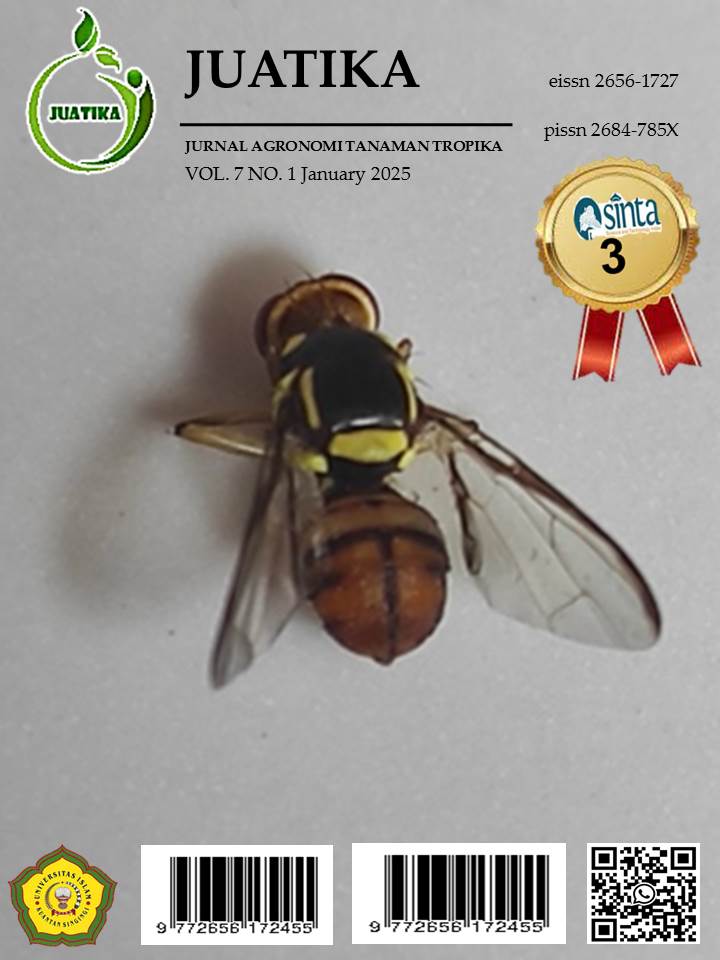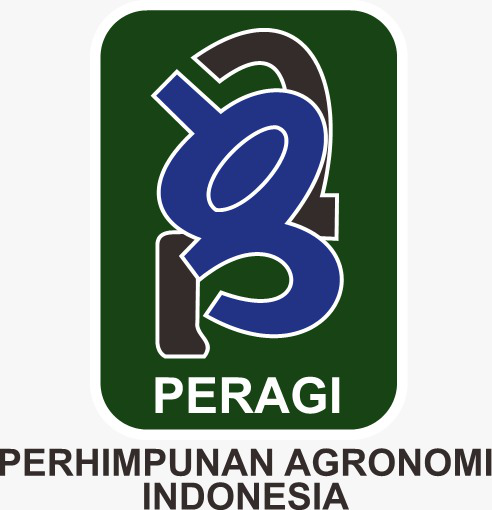Optimization of Liquid Organic Fertilizer Concentration of Banana Stem on Cucumber Plant Growth (Cucumis sativus L)
Abstract
Cucumber (Cucumis sativus L.) is a vegetable from the Cucurbitaceae family. Cucumbers are fruit vegetables that offer numerous benefits in people’s daily lives, leading to a high demand for this commodity. This fruit is popular across all levels of society, necessitating a relatively large and sustainable supply. This study examined the growth of cucumber plants under the influence of banana stem liquid organic fertilizer (LOF). The research employed a non-factorial Randomized Block Design (RAK) with two replications to assess how banana stem LOF impacts the growth of cucumber plants. Six treatment doses were used: 0 (control), 30%, 35%, 40%, and 45%. The results revealed that plants treated with a 200ml dose of LOF exhibited a higher growth rate than other doses. At the same plant age, the tallest plants were observed at the 200ml dose, while the lowest number of leaves was recorded at the 0 dose. The study identified that applying a 200ml dose of LOF at 5MST significantly impacted plant growth compared to other treatments. The findings suggest that a 200ml dose of banana stem LOF is highly suitable for promoting the growth of cucumber plants. These results can serve as a guideline for achieving optimal cucumber plant growth.
Downloads
References
Arancon, N. Q., Edwards, C. A., Bierman, P., Welch, C., & Metzger, J. D. (2004). Pengaruh vermikompos terhadap stroberi lapangan: Efek terhadap pertumbuhan dan hasil. Bioresource Technology, 93(2), 145–153.
Ari. (2009). Upaya peningkatan produksi mentimun (Cucumis sativus L.) melalui waktu pemangkasan pucuk dan pemberian pupuk posfat. Skripsi. Universitas Pekalongan.
Brady, N. C., & Weil, R. R. (2016). The nature and properties of soils. Pearson Education.
Cahyono, R. N. (2016). Pemanfaatan daun kelor dan bonggol pisang sebagai pupuk organik cair untuk pertumbuhan tanaman bayam (Amaranthus sp.). Publikasi Ilmiah.
Hartz, T. K., & Johnstone, P. R. (2006). Ketersediaan nitrogen dari pupuk organik dengan kandungan nitrogen tinggi. HortTechnology, 16(1), 39–42.
Imdad. (2001). Sayuran Jepang. Jakarta: Penebar Swadaya.
Juwita, M., & Sudartini, T. (2007). Pertumbuhan dan hasil mentimun (Cucumis sativus L.) varietas Venus pada frekuensi dan konsentrasi mikroba efektif yang berbeda. Jurnal Penelitian Bidang Pertanian, 2(1), 17–22.
Khotimah, N. (2007). Budi daya tanaman pangan. Karya Mandiri Nusantara.
Prabowo, D. P. (2009). Survey hama dan penyakit pada pertanaman mentimun (Cucumis sativus L.) di Desa Ciherang, Kecamatan Pacet, Kabupaten Cianjur, Jawa Barat. Skripsi. Institut Pertanian Bogor.
Prasetya, D. (2020). Optimalisasi pupuk organik cair pada tanaman hortikultura. Journal of Agricultural Sciences, 15(2), 120–130.
Rahma, R. (2014). Penyimpanan buah timun suri (Cucumis sativus L.) menggunakan kemasan pelepah pisang. Skripsi. Fakultas Pertanian, Universitas Syiah Kuala.
Rahman, A. (2021). Effect of organic liquid fertilizer on plant growth and soil microbial activity. Soil and Plant Sciences, 9(1), 45–60.
Rahmadani, S. (2016). Penampilan fenotipe beberapa genotipe tanaman mentimun (Cucumis sativus L.) di Kecamatan Pauh Padang. Skripsi. Fakultas Pertanian, Universitas Andalas.
Siboro, E. S. E., Surya, & Herlina, N. (2013). Pembuatan pupuk cair dan biogas dari campuran limbah sayuran. Jurnal Teknik Kimia USU, 2(3), 40–43.
Sharma, O. P. (2002). Plant taxonomy. New Delhi: Tata McGraw-Hill Publishing Company Limited.
Sumpena, U. (2001). Budidaya mentimun intensif dengan mulsa secara tumpang gilir. Penebar Swadaya.
Sunarjono, H. (2005). Mentimun: Budidaya untuk menghasilkan buah prima. Penerbit Swadaya.
Suherman. (2004). Pengaruh dosis pupuk kandang sapi dan konsentrasi Gandasil B terhadap pertumbuhan dan produksi tanaman mentimun (Cucumis sativus L.). Skripsi. Fakultas Pertanian
Copyright (c) 2025 Dendy putra aulia siregar, Novilda Elizabeth Mustamu, Yudi Triynto, Hilwa Walida

This work is licensed under a Creative Commons Attribution 4.0 International License.
Authors who publish with Jurnal Agronomi Tanaman Tropika (JUATIKA) agree to the following terms:
Authors retain copyright and grant the Jurnal Agronomi Tanaman Tropika (JUATIKA) right of first publication with the work simultaneously licensed under a Creative Commons Attribution License (CC BY 4.0) that allows others to share (copy and redistribute the material in any medium or format) and adapt (remix, transform, and build upon the material for any purpose, even commercially) with an acknowledgment of the work's authorship and initial publication in Jurnal Agronomi Tanaman Tropika (JUATIKA).
Authors are able to enter into separate, additional contractual arrangements for the non-exclusive distribution of the journal's published version of the work (e.g., post it to an institutional repository or publish it in a book), with an acknowledgment of its initial publication in Jurnal Agronomi Tanaman Tropika (JUATIKA). Authors are permitted and encouraged to post their work online (e.g., in institutional repositories or on their website) prior to and during the submission process, as it can lead to productive exchanges, as well as earlier and greater citation of published work.







 More Information
More Information



